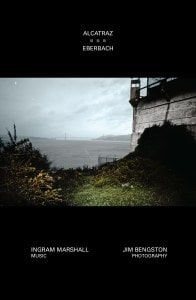Ingram Marshall’s haunting, elegiac music and Jim Bengston’s stark, striking photographs, created for their joint multimedia work Alcatraz, can now be experienced as a recording for the first time. The work explores this forbidden island and its famous prison, which once held the most notorious criminals in the US.
This new Starkland DVD also premieres the complete audiovisual presentation of Eberbach, their followup work, that focuses on an impressive, abandoned German monastery, Kloster Eberbach. Marshall’s seductive music reflects the spacious acoustics, and Bengston’s photos capture the striking architecture.
In addition, the DVD adds immersive surround sound mixes of the music in both works, newly created for this release by Marshall.
Here’s an Alcatraz preview:
In the early 1980s, Marshall and Bengston jointly created Alcatraz, in an unusual arrangement where both the music and visuals were equally important from the start. Equipped with tape recorders and cameras, they explored this austere island in the San Francisco Bay. After exchanging slides and cassettes between San Francisco and Norway for several months, the final interwoven work emerged as a series of evocative still photographs with live, electronically processed music.
Bengston and Marshall performed Alcatraz and Eberbach at many venues since 1984, including the Henie Onstad Art Center (Oslo), The Museum of Contemporary Art (Ghent), the new music festival at Bourges, The American Center (Paris), The Art Institute of Chicago School, and Carnegie Recital Hall (New York). In 2009, Bengston and Marshall had a residency at The Montalvo Art Center (Saratoga, CA), where they performed and held talks about both pieces. Concurrently, Alcatraz was shown on monitors in the public spaces of Walt Disney Hall in Los Angeles.
To create the new surround sound mixes for this DVD, Marshall worked closely with recording engineer Tom Lazarus, and the DVD was mastered by Silas Brown. Both engineers are winners of Grammy awards.
About Ingram Marshall
Marshall studied at Columbia University and California Institute of the Arts, and lived and worked in the San Francisco Bay Area from 1973 to 1985. During that time, Marshall developed a series of “live electronic” pieces such as Fragility Cycles, Gradual Requiem, and Alcatraz in which he blended tape collages, extended vocal techniques, Indonesian flutes, and keyboards. In recent years, Marshall has concentrated on music combining tape and electronic processing with ensembles and soloists. His music has been performed by ensembles and orchestras such as the Kronos Quartet, Bang on a Can All-Stars, Los Angeles Philharmonic, San Francisco Symphony, St. Louis Symphony, and the American Composers Orchestra. Marshall has received awards from the National Endowment for the Arts, Rockefeller Foundation, Guggenheim Foundation, and the American Academy of Arts and Letters. Recent, larger works include Dark Florescence (a concerto for two guitars and orchestra premiered by the American Composers Orchestra at Carnegie Hall in 2005), Orphic Memories (premiered by the chamber orchestra Orpheus in 2007 at Carnegie Hall), and Psalmbook (premiered by the vocal ensemble Lionheart and the American Contemporary Music Ensemble at Stanford University in 2012). His music can be heard on the Nonesuch, New Albion, New World, and Starkland labels. Since 2005, Marshall has been a Visiting Lecturer at the Yale School of Music.
About Jim Bengston
Jim Bengston attended Lake Forest College (where he met Ingram Marshall), entered graduate school at Princeton University, and shortly thereafter left to join the Army, where he developed an interest in photography. After serving as an Associated Press photo editor in New York, Bengston moved to Norway, and since 1975, he has been a freelance photographer in Oslo. Bengston’s work is represented in the collections of several museums, including MoMA, Art Institute of Chicago, Walker Art Center, National Museum of Art, Architecture & Design (Oslo), The Museum of Photographic Art (Denmark), The Finnish Museum of Photography, and the Bibliotheque Nationale (Paris). He has published three books: Afterwords (self-published, 1978), Slow Motion (European Photography, Germany, 1986), and Empty Landscape (Lillehammer Art Museum, 1996). Winner of first prize in the Nikon International Photo Contest in 1970, Bengston has had his work featured in shows at MoMA, 1978; International Center of Photography, New York, 1987; Berlinische Galerie, 1992; a one-person show at Lillehammer Art Museum, 1996; Drammens Museum, Norway, 2007; and Risør Foto Festival, Norway, 2009. Since 2010 he has been working on a new series of scenes and street pictures from Las Vegas, Nevada.








